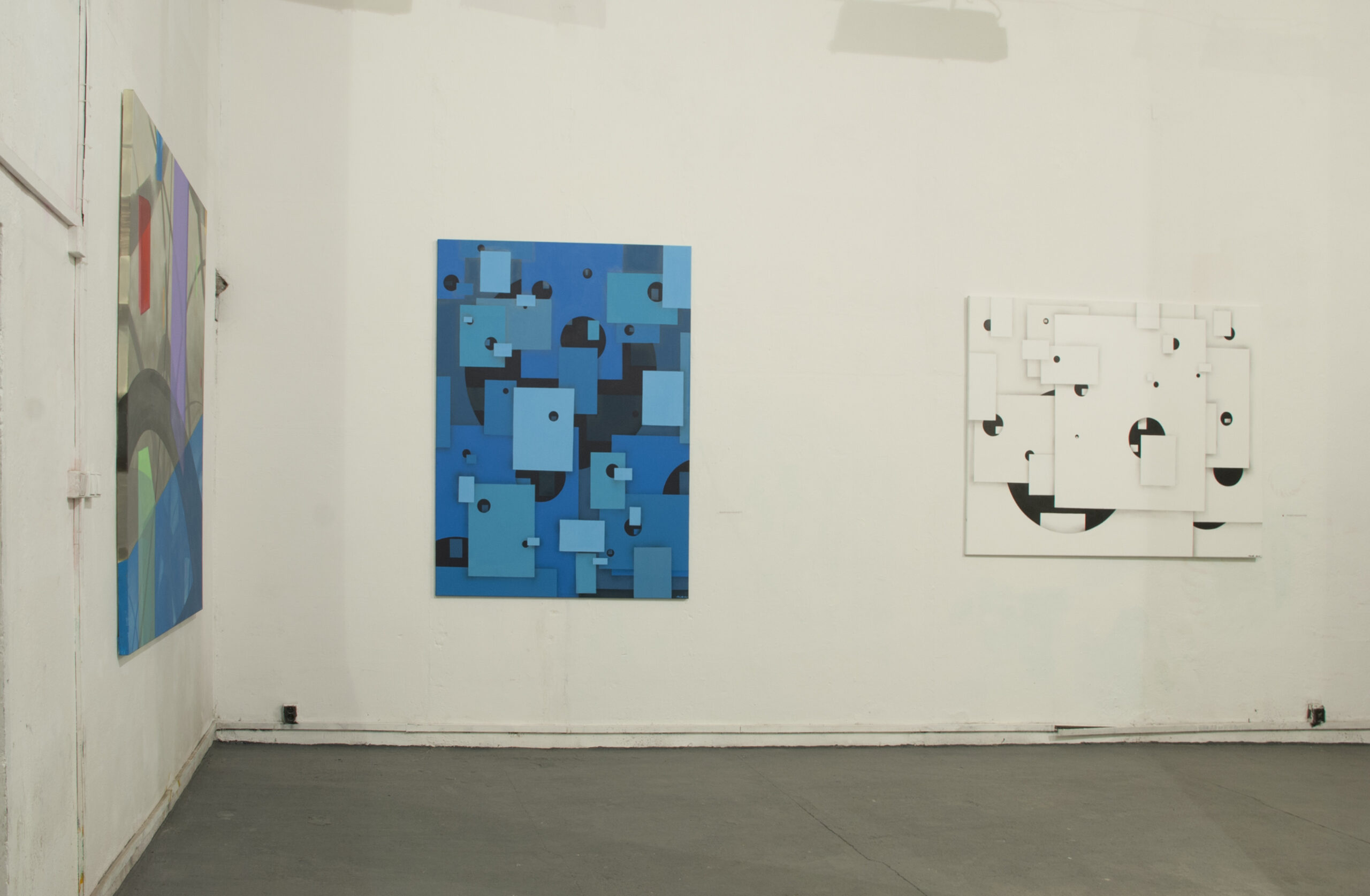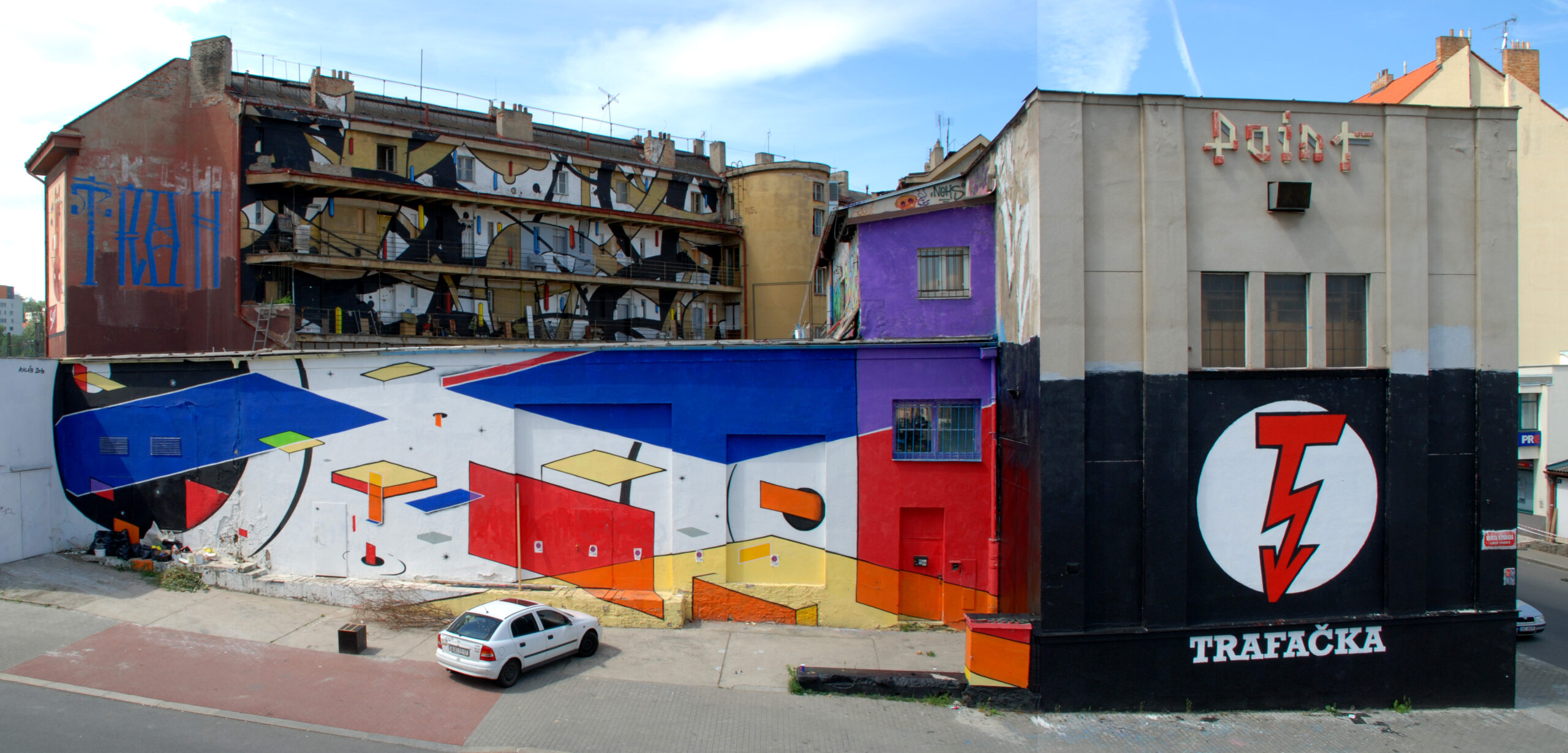Suspended Planes by Karel Srp
Graffiti enthusiasts may be surprised to see one of their main representatives, formerly known under the pseudonym Point, has abandoned the outdoors and graffiti based on his adopted name in favour of hung pictures in a format large enough to cover an entire wall. These hung pictures have required a new approach, different to Point’s original orientation. The author’s large body of works from the past two years clearly shows that the abstract language, whose established and extended morphology he adopted as a building set permitting an indefinite amount of permutations, has lead him to build a new rapport with space, quite different to the one he maintained over the past ten years when he focused largely on locating suitable places for his bold and striking sprayer acts as well as objects often installed on cornices, well above eye-level, noticed only haphazardly and most likely to the surprise of pedestrians. The key turning point is represented by the moment when Point began writing his name on canvas, instead of a wall. He made large, structured hung pictures, still using the spraying technique. The individual letters took the shape of intertwining geometric forms, only a step away from the liberated intersecting planes floating in space. The attempt to overcome the relational space that suppresses traditional relationships such as up-down, right-left, in front-behind, had already been manifested in those transitory paintings where the point of view was still dictated by the margins separating individual colour planes. In the following few years Point re-emerged as Jan Kaláb and even took to providing his art works with a signature in the bottom right corner. His hung pictures remain in coordinates free from anthropomorphic scale and illusory perspective; no distant point, placed in the depth of space, takes the sight back to the spectator’s retina; on the contrary, the gaze is being drawn in to the diverging folds, curves and corners that lead to secret places.

Installation view
Kaláb’s latest works resonate with the approach of the pioneers of abstraction from the beginning of the last century who introduced both purely geometric space, made of austere, intersecting planes, and the cosmogonist space that exists outside the law of gravity and which they believe to open up interplanetary correlations. Kaláb handles both these elementary concepts, nowadays considered the inventions of modern painting, as constants which he adopted naturally, without studying the historical context: on the one hand he is attracted to axonometric projections, opening more and more, endless apertures whose end is nowhere in sight, on the other hand he contemplates bottomless depths, revealing the abyss filled with action the meaning of which transcends the painter’s consciousness. On both those levels, symbolic forms, arising both from reassessment of the illusory perspective and psycho- logical structures that reflect the desire to transcend into the realm beyond sensory experience, are intertwined, each in harmony with the other. Kaláb thus draws upon the contrasting aspects of meaning that have been associated with art from the beginning of its existence, although, seen with the hindsight of many decades, they merely provide the margins for his decisions. He has arrived at them following a path of his own which arose in front of him naturally as a painter’s task, not by an intentional study of an already existing language that sees abstraction from a distance, as one of many possible painting styles.
As one of Kaláb’s main means of expression, the monochrome planes suggest they do not serve merely to hold one’s sight which uses them as a fixed reference point. As soon as we try to define which of them is the highest and the lowest, we find ourselves in doubt. Each has a natural potential to progress into another space. Their interconnectedness verifies the cohesiveness of Kaláb’s
compositional abilities. These intersections are visible in Kaláb’s sizeable picture titled Planets Crossing where white and black planes serve merely as imaginary borders representing the lower and the upper part of the surface. Both in front and behind them are a small little square and a red circle, representing the deepest and the uppermost layers. Kaláb’s space is disembodied, rid of the presence of human figure as a scale of all things and the centre of the inner space and universe, free from the constricting gravity and independent on the visual field of the spectator. Its sensory value is in contrast to his earlier graffiti.
Kaláb builds his imaginary world on several prerequisites, represented by two opposing shapes – a sphere and a cube, a circle and a square, which have become the springboard for further transformations. He penetrates them, opens them up, discovering new spaces beyond their surface; he emphasises the hollowness of the sphere and makes his cube lose its individuality by separating the individual sides to blend in with its surroundings. Both Kaláb’s sphere and cube have the same value, the same as black and white does. However, each form could be contained in the other. The circle emerges out of the surface of a square which itself contains a cube. The interconnectedness maintains the alternation of two crossing points of view, the lower and the upper, which provide the paintings their motion. Balancing the two opposing points of view is an important feature of Kaláb’s approach, which is grounded in theories of perception dealing with various breaks and transformations of plane into space as described by William James in his book The Principles of Psychology (1890), a study on ambiguity and inversion, where one and the same form can be seen both as the closest to the spectator and at the same time the most distant. This observation was further developed by M. C. Escher, who drew the spectator into his optical illusions. Kaláb uses these qualities as foundation stones, serving to create both the view from above and beneath. He mainly employs contrasting passages that reveal the void seemingly to be found on the other side of the surface.
The main feature of Kaláb’s abstract paintings is the conflict between shapes as pure forms that remains unresolved. He is seduced by violent penetration, stemming from the contact of curves and lines. The edges of cubes sometimes perforate spheres. Bizarre clusters, reminiscent of scientific diagrams, give birth to contrasting ornamental sequences, one based on regular, repetitive struc- tures and exact forms, another on a transforming mass of colour. Their combination yields a new whole, sometimes approximating a crystal with numerous perforations. Kaláb moves between order and chaos, a solid structure and embryonic matter to which he sometimes refers as nebula. Both the positions represent the utmost extremities within which flexible lines cross one another, de- limiting the depth of space that is from all sides being entered by diagonal shapes, reminiscent of beams and girders which however remain materially undefined. The universe of Kaláb’s latest paintings is held together by a subconscious criterion that is sometimes more and sometimes less visible. This is clearly manifested in the painting titled Verticals. It draws upon the preliminary thought from the Emerald Tablet which influenced already the pioneers of abstraction: “This is true and remote from all cover of falsehood. What- ever is below is similar to that which is above. Through this the marvels of the work of one thing are procured and perfected.”

Installation view

Installation view

 Back to overview
Back to overview